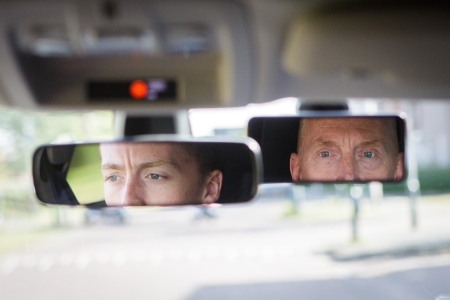What should be assessed in driving test B is laid down in two legal provisions: the rules for requirements for the theory test of driving licence category B (in Dutch) and the rules for requirements for the practical test of driving licences categories B and BE (in Dutch). These two sets of rules are based on the third driving licence directive of the European Union. In the Netherlands, the Dutch Driving Test Organisation (CBR in Dutch) is responsible for driving tests.
Theory test
The theory test assesses knowledge of:
- traffic rules
- matters that have a negative impact on driving skill (for instance alcohol and fatigue)
- safe vehicle spacing, braking distance and speed
- the behaviour of other road users, particularly that of vulnerable road users (pedestrians and cyclists)
- the driving licence itself (for instance the period of validity) and other documents (for instance insurance)
- the use of means of protection (for instance seat belts and child restraint seats)
- a few technical aspects, such as inflation pressure of tires
- eco-friendly driving (see for instance the principles of Ecodriving)
- hazard perception
Hazard perception questions have been part of the theory test since 2009 (also see the question How useful is hazard perception as part of driver training and driving tests?). When confronted with photographs taken from a driver’s perspective, the candidate has to indicate whether he or she would brake, would release the accelerator, or maintain speed. The present speed is presented at the bottom of the picture. For a few years now, CBR has been working on a hazard perception test with moving images that should replace this photo test. The theory test now also has more questions concerning judgement. These questions, about the risk of driving during certain weather conditions for instance, have replaced questions like ‘The car in this picture wants to turn left. Is that allowed?’
Practical driving test
During the practical driving test, the candidate drives for about 35 minutes in the presence of an examiner. Before departure, the candidate has to check the vehicle and adjust the driving position (and for example adjust the mirrors). During traffic participation, the following skills are assessed: vehicle control, following traffic rules in specific traffic conditions, and how special manoeuvres are carried out, such as parallel parking or reversing around corners. About 10 minutes of the driving test are reserved for following navigation system instructions. The Driving procedure (in Dutch) states how the candidate is required to act when departing, driving and exiting the vehicle.
It is possible to practice the driving test in an intermediate test. This intermediate test takes just as long as the real driving test and contains the same elements. Thus, candidates may get used to test conditions and receive tips from the examiner. If the special manoeuvres are carried out correctly during the intermediate test, candidates obtain exemptions for these manoeuvres during the official driving test.
